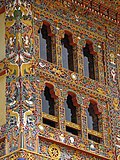Gangteng Monastery
The monastery is one of the main seats of the religious tradition based on Pema Lingpa's revelations and one of the two main centres of the Nyingmapa school of Buddhism in the country.
A Nyingma monastic college or shedra, Do-ngag Tösam Rabgayling, has been established above the village.
The descent of the first king of Bhutan, Gongsar Ugyen Wangchuck of the Wangchuck Dynasty of Bhutan, which continues to rule Bhutan is traced to the clan of the Dungkhar Choje, a subsidiary of the clan of Khouchung Choje whose founder was Kunga Wangpo, the fourth son of Pema Lingpa.
Geography
The Gangteng Monastery, also spelt Gantey Gonpa, bounded on the west side by the Black Mountains (Bhutan) (range above 5,000 metres (16,000 ft) elevation) is located on a spur amidst the Gantey village, overlooking the vast U-shaped glacial Phobjikha Valley, which is at an elevation of about 3,000 metres (9,800 ft) and which has marshy land. The Nake Chuu river runs through this valley. The monastery commands striking views of the Phubjika Valley below. The Black Mountain Region is inhabited by nomadic shepherds and yak-herders.
Wangdue Phodrang, the district headquarters, is 45 kilometres (28 mi) from the Nobding village in the Phobjikha Valley on the Trongsa road from where a short diversion road leads to the Gonpa. It is 75 kilometres (47 mi) to Thimphu, the capital of Bhutan. The Gonpa lies on the popular trekking route of the 'Gangte trail' which starts from the bottom of the Phobjika valley, passes through the Gangteng Valley, then climbs up to the Gangteng Gonpa, then goes through the Kumbu village on the east of the Gangteng Gonpa, passes through Gedachen, Khebaythang, the Kilkhorthang villages and finally touches the Kungathang Lhakhang.
History
The Gangteng Monastery, also called the Gangteng Sangngak Chöling སྒང་སྟེང་གསང་སྔགས་ཆོས་གླིང་, was established in 1613 by the first Peling Gyalsé Rinpoche or Gangteng Tulku, Rigdzin Pema Tinley (1564–1642), who was the grandson of the great Bhutanese "treasure revealer" Terchen Pema Lingpa (1450–1521). The earliest historical background relevant to this monastery is traced to establishment of the Vajrayana tradition of Buddhism, by Guru Rinpoche, who was instrumental in making Bhutan a Buddhist nation. The Guru, during his visits to the country in the 8th and 9th centuries, had hidden many sacred treasures (called terma) (images and scriptures), to avoid their desecration or destruction during troubled times, at various places in Bhutan to be retrieved in later years by treasure finders, to propagate the teachings of Buddha. These were retrieved at various periods over time and in the 15th century Pema Lingpa, born in 1450, considered an incarnation of Guru Rinpoche, prompted by a revelation of 108 treasure coves in his psychic dream revealed by his Guru Rinpoche. He embarked on the treasure hunt in 1476 when he was 25 years of age. He was successful in locating many treasures of images and scriptures related to Buddhism throughout Bhutan, which resulted in establishing many monasteries throughout Bhutan, and Buddhism took firm roots in the country. Consequently, Pema Lingpa came to be known as the "King Terton", a revered saint and teacher. The Terton, came on a visit to the Phobjikha Valley as a saint to teach Buddhist precepts to the people and also to bless them. During this visit, after looking at the impressive mountains that surrounded the valley he had foretold that one of his descendants would build a monastery or gonpa on the Gangten (meaning top of the mountain) and make it famous as the seat of the Peling tradition. This prediction fructified when a monastery was built by his grandson Gyalse Pema Thinley in 1613, and the spur of the mountain was given the name, the Gangteng Sang Nga Choling (meaning: "summit for the teaching of the dharma"). He became the first Trulku (spiritual head of the monastery or gonpa) of the monastery. It was initially built as a Lhakhang, a small village monastery, which was later expanded by his son Tenzing Legpai Dhendup (1645–1726), who succeeded him as the second Trulku. It was built like a Dzong (fortress). The present Wangchuk Dynasty, which rules Bhutan, are descendants of Pema Lingpa.
From 2002 to 2008, the monastery has been completely restored under the present Gangteng Tulku, H.E. Rigdzin Kunzang Pema Namgyal (b. 1955). The rebuilt monastery was consecrated by the present incarnation of Pema Lingpa on the October 10, 2008, graced by the fourth King of Bhutan. Gangteng Sang-ngak Chöling, as now restored, retains its original glory and is stated to be the resurgence of the Peling Tradition.
In the context of the 1864–65 battle fought between the British Army and the Bhutanese Army at Deothang in Bhutan, it is mentioned that the hands of the British military officer that was severed in the battle have been "preserved in the sanctum sanctorum of the Gangteng Gonpa."





